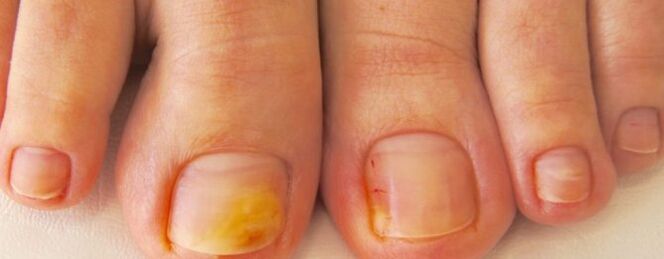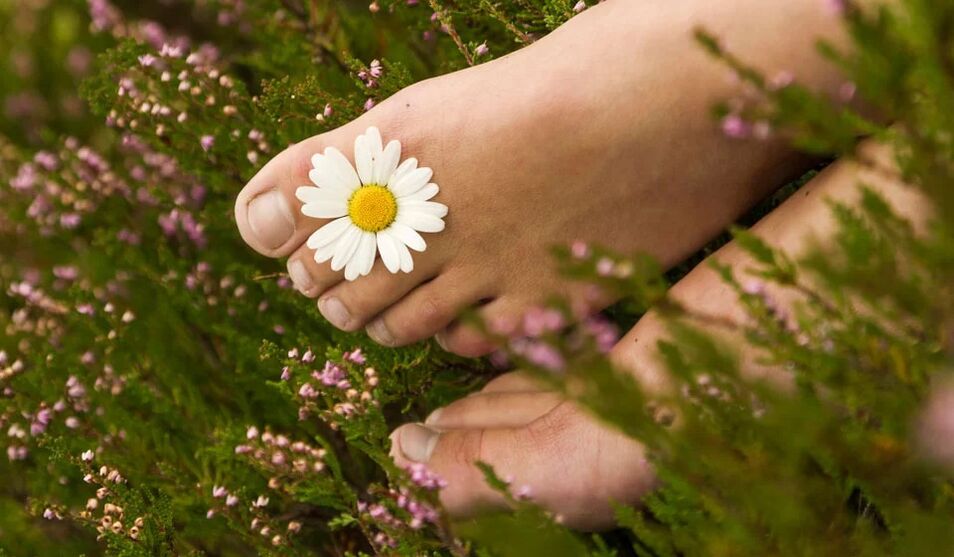In medicine, nail fungus is officially called onychomycosis.This is a fungal disease that affects nail plates in the fingers or legs.According to WHO, this is a fairly common disease.It occurs in approximately 27% of people, and in their legs the pathology is diagnosed 2 times more often than in their hands.The problem of nail fungus is very delicate, since the unpleasant type of affected plates makes the patient feel discomfort and hide them from others.
Symptoms and signs of nail fungus
Onichomicisis is very easy to recognize, since its nail signs cannot be ignored.At first, nail plates become opaque and rough, they lose their bright brightness.Then, instead of rose, the nail acquires dirty yellow, whitish or gray.Next, other characteristic symptoms of the fungus appear:
- an increase in plate thickness;
- Defects in the form of stripes, curves, irregularities and waves;
- Relaxing and locating the dish;
- An unpleasant smell of the nails.

As a result, the nail is completely destroyed and even exfolia, exposing the bed under the nail.The skin next to the plates becomes red and causes severe itching.
Causes
The main reason for the development of fungal infections is to enter the body or within the human body.As a general rule, these are MikRosporum, Metridium and Epidermofiton.These are fungi cause onylomycosis, especially often.
When he enters the body, these fungi are located in keratinized skin derivatives, that is, nails and hair.This is due to the nutrition of parasites for which they use fibrillar protein keratin, which is available in nails and hair.
Forms of infection
The risk of obtaining an infection with a fungus in public places with high humidity is especially high.These are saunas, swimming pools, gyms, public bathrooms, etc.The most common forms of infection:
- Direct contact with an infected person.Here the fungus falls from its habitat in healthy areas, thus causing an infection;
- Home Road.In this case, the infection occurs when using the patient's personal things: shoes, personal hygiene items, etc.
Risk factors
The incidence of onylomycosis increases by 60 years.At this time, the probability of developing this infection is 60%, which is explained by a slowdown in metabolism, especially in distal (remote) areas of the body, which are only fingers and legs.
Other risk factors for nail fungus development include:
- diabetes mellitus;
- varicose veins;
- adjacent nail and tissue injuries;
- HIV and other states of immunodeficiency;
- long -term antibiotic intake;
- weakened immunity;
- Vascular and skin diseases, dermatitis, diaper eruption;
- Blood supply altered to the limbs;
- Insufficient hygiene.
Complications
With a course without complications, the disease causes traditional symptoms for the fungus, causing a person only serious discomfort.But without treatment, onylomycosis can cause complications.Very often, they appear in the addition of a bacterial infection.
Sometimes, onychomycosis is very acute with the advent of bubbles, ulcerations and crying areas on the skin next to the nail.In severe cases, the disease acquires a generalized form.This means that nail fungus applies to internal organs and systems, and then the patient will need emergency hospitalization.
When to consult a doctor
Many of those who have encountered onychomycosis know that the disease develops slowly and is treated with incredible birth.That is why it is very important to consult a doctor when the first signs of the disease appear.The treatment of nail onylomyosis is dedicated to a dermatologist.The specialist will provide competent assistance and take it to a complete recovery.
Preparation for a visit to a doctor
Before taking a dermatologist, it is important not to process the affected areas of the nails, that is, do not use medications, including iodine and green.It is also necessary to exclude the use of creams and fungus ointments.It is worth taking all the tests performed above, including other diseases.Affected nails cannot be cut for 3-4 days before consultation.
Diagnosis of nail fungus
First, the patient goes to microscopy, which allows him to identify the presence of the pathogen.In the future, it is necessary to determine its variety to choose the correct treatment of the nail fungus on the legs.The most modern and common methods are practiced to diagnose onychomycosis:
- Bacteriological planting.For this, a biological sample of affected tissues is placed in an artificial nutrient medium, where the pathogen is cultivated to determine its type;
- The polymerase chain reaction method (PCR) to detect the pathogen DNA in the sample taken from affected tissues.
Treatment
In the early stage of the disease, as a rule, local therapy is prescribed, which consists in the use of creams and ointments with antimicotic effects.
Antiseptic solutions are also used as external products from the nail fungus.In addition to effective nail onylomycosis tools, antihistamines and desensitizing medications are prescribed, which relieves swelling, inflammation and sensitivity.
If the nail is completely affected by the fungus and pharmacological treatment does not give positive results, then the plaque is subject to surgical elimination.In addition, with a total form of onychomycosis, antifungal drugs are prescribed inside tablets, which have a systemic effect on the body.
Home treatment products
Before using home treatment funds, you should consult a doctor.Due to its resolution, you can use the following recipes:
- iodine.Before using the leg, it is necessary to vaporize, rinse with home soap and then remove the affected areas of the nail plates.Then, try the nails and the skin between the fingers with iodine, resist them in a bathroom with a soda solution for 20-30 minutes and dry completely;
- vinegar.For 3 liters of water, take 1 tablespoon.Apple cider vinegar and add some potassium permanganate.Keep your legs in the bath for 20-30 minutes, then dry well;
- Hydrogen peroxide.Vaporize the legs thoroughly, eliminate the affected areas of the nail plates.Put on the cotton wheels moistened with hydrogen peroxide, wrap with a bandage and go for half an hour.
Myths and dangerous delusions in the treatment of nail fungus
One of the most important and dangerous myths is that nail fungus is not considered a serious illness.In fact, onychomycosis, progressing, can lead to serious consequences to the deformation and complete rejection of the nails of the nail bed.
In addition, an infected person is a danger to loved beings daily, because, next to him, they also risk getting sick.That is why it is important to know how to cure the fungus of the nails in time.
Prevention
To prevent the development of onychomycosis, it is necessary to exclude the negative effect on the body of risk factors:

- Treat system diseases in time;
- Do not wear another person's shoes;
- in the pool and sauna to walk in lutitas;
- Change the socks daily and follow personal hygiene rules;
- Do not wear wet shoes, dry it well;
- Exclude direct contact with possible means of origin.
















